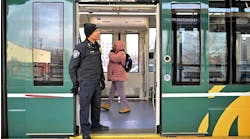TriMet is proposing to increase revenues to meet the demand for more transit service. The region is expected to grow by the equivalent of four new Hillsboros over the next 20 years with 400,000 new residents and 260,000 new jobs.
TriMet is proposing to increase the payroll and self-employment tax rate by 1/10th of one percent phased-in over 10 years. If approved, the median firm would see their tax increase by slightly more than $8 in the first year and by about $82 by the end of the decade, not including inflation. At the Aug. 12 Board of Directors meeting, there will be a first reading and a public hearing on the proposal.
Dedicated to more and better service
The added revenue would be dedicated to new and expanded bus, rail and innovative community and job connector services that are outlined in the agency’s comprehensive strategic Service Enhancement Plans (SEPs). The SEPs are shared visions for the future of transit that were created after meeting with key stakeholders, businesses, residents and riders over the past four years. The SEPs have been developed for theWestside, Southwest, Eastside, North/Central and Southeast sectors, and identify and prioritize how best to expand transit in each area.
Background
The 2009 Oregon Legislature gave TriMet the authority to increase the employer payroll tax rate, currently at 0.7237 percent, by 1/10th of 1 percent phased-in over 10 years.
TriMet did not take action to increase the rate due to the Great Recession, and the need for the agency to realign its cost of benefits and wages to be more efficient with its revenues. With internal efficiencies and changes to benefits and wages, TriMet is now on a sustainable financial path for the long-term and focused on improving service to meet demand while helping to ease congestion.
The 2009 legislation requires the Board to make a finding that the regional economy has sufficiently recovered to warrant the adjusted rate. To make its finding, the Board commissioned a report by an independent economics firm, ECONorthwest, and considered state and federal economic reports. The Board found that total employment is well above pre-recession levels and unemployment is approaching levels not seen since high economic growth periods like 2002. Based on the jobs data and positive economic indicators, the board concluded that the economy has improved sufficiently to warrant the increase.
During the spring, TriMet staff met with major payroll tax payers, chambers of commerce, business associations and small business groups to discuss the proposal and solicit feedback. In July, the Board heard from businesses and community groups at open houses and at its monthly meeting.
Next steps
The board is set to vote on the ordinance at its Sept. 16 meeting. If approved, it would take effect on January 1, 2016. The proposal also calls for a review of the revenues after the first five years. If the revenues materially exceed the annual amounts necessary to expand service to meet state and regional plan requirements and maintain sufficient financial reserves, the Board may defer the payroll tax increase for any subsequent year.
Paying for more and better service
In order to implement the vision for more service and stay ahead of growth and ease congestion, TriMet needs additional funding. TriMet has talked with the community to determine if now is a good time to increase the employer payroll tax, which funds about 59 percent of transit service. Many large employers have expressed support for the increase because it will connect workers to jobs.
The median firm would see a first year increase of $8.19 and an increase of $82 at the end of 10 years. The median self-employed individual would see a first year increase of $1.62 and an increase of $16.17 at the end of 10 years, not including inflation.
“To stay ahead of the tremendous growth in residents and jobs, we must invest more in both roads and transit,” said TriMet General Manager Neil McFarlane. “Investing in our transportation infrastructure will help keep our region moving and economy growing, and not let congestion drive what happens in our communities.”
The 2014 Portland Business Alliance Cost of Congestion study shows that the growth in jobs and residents means more travel, more freight, more demands on the existing transportation system and more congestion. It found that investing in transit and roads would reduce that impact by almost half, while generating nearly $1.1 billion in economic benefits and more than 8,300 more jobs per year by 2040. That means for every $1 spent on roads and transit, there’s a return of $2.40.
Vision for new service
Transit is part of the solution allowing freight and cars to move more freely on our roads.
As the region is changing and jobs spread around the region, transit is also changing. Here’s a sampling of ideas for expanding service in each of the SEP sectors:
- More frequent bus service, including new Frequent Service lines on 122nd Ave, 181st/182nd Aves in Rockwood, and between Beaverton, Orenco and Hillsboro
- Bus Rapid Transit on Powell/Division between downtown Portland/SE Portland and Gresham/Mt. Hood Community College
- Extending MAX Red Line service from Beaverton to Hillsboro, providing direct service to PDX
- New bus lines and more connections to more places, such as on NE/SE 162nd, between Sherwood and Tualatin, and between Gresham and Troutdale Reynolds Industrial Park, connecting SE Portland to the Columbia Corridor.
- Innovative community and job connectors in suburban and employment areas to address the “last mile” connection issue. These programs have been successful in Forest Grove and Tualatin and the SEP calls for examining added shuttles in areas such as North Hillsboro, Rivergate, East Columbia Corridor, Clackamas Industrial area and Cedar Mill/Northwest Heights areas.
